Breaking news
Kamchatka to receive two latest minesweepers of Project 12700 in 2020.
Two latest Alexandrite-class minesweepers of project 12700 will arrive in Kamchatka next year. They are armed with unmanned underwater and surface craft which remotely detect and destroy mines. In wartime, the minesweepers will have to clear waters around naval bases of mines to let nuclear submarines out, the Izvestia daily writes.
 First Project 12700 Alexandrit-class minesweeper (Picture Source: Sredne-Nevsky Shipyard)
First Project 12700 Alexandrit-class minesweeper (Picture Source: Sredne-Nevsky Shipyard)
Minesweepers of project 12700 are new-generation warships for mine clearance in coastal waters. The Navy operates two of them - the Alexander Obukhov and the Ivan Antonov. Several others are to be commissioned next year.
The minesweepers are expected to play a major role in future conflicts as mines are actively developed. Until recently the mine arsenal of the US Navy was outdated, leading expert of the Center for Naval Analysis Mikhail Kofman said. "When the United States waged a war in Afghanistan and Iraq, naval mines were no priority. But the situation has changed. Mk.65 mines have been upgraded. Besides, air mines of the QuickStrike family are modernized. They carry a GPS guidance and adjustment system. The mines can be dropped from a major altitude at a distance of dozens of kilometres from the target. It considerably increases their effectiveness," he said.
The exact number of naval mines in the US Navy is not disclosed. Various estimates say they can number 10 thousand. US media said strategic B-52H bomber took off from Guam to drop mines during Valiant Shield exercise in 2018.
The Russian Navy operates several dozen minesweepers, but most are outdated. The Russian defence industry has to catch up. Project 12700 minesweepers are 60 meters long with an 800-ton displacement. Their command post is equipped with automatic controls which accumulate real-time underwater information.
The Diamant system was designed to detect and destroy mines. It comprises two light carbon fibre unmanned underwater craft armed with devices resembling torpedoes. They replaced the French unmanned craft which had to arm the minesweepers.
The minesweeper floats the boats in the assigned area. They can safely inspect the area as mines do not react to their plastic hull and silent engine. The boats detect mines by sonars and magnetometers and submerge underwater robots to destroy the munitions. The boats can operate at a distance of ten kilometres from the minesweeper and detect and destroy mines at a depth of 10 to 100 meters.
Project 12700 minesweepers have a monolith fibreglass hull which demanded to design new technologies, equipment and software. Russia has become the only country in the world which produces 80-meter long monolith hulls from composite materials. The fibreglass with minimal physical fields makes the warship invisible for magnetic detonators of naval mines. The durability of the hull does not cede to steel.
Rear Admiral and Hero of Russia Vsevolod Khmyrov believes the minesweepers will play a key role in modern war. "There is nothing more dangerous than mines at present. They are becoming trickier and are equipped with magnetic, acoustic and other detonators operating on different physical principles. Existing doctrines stipulate the use of mines not only for blocking naval bases. The weapon can be used in narrow straits, convoy routes, and potential areas of deployment and patrol by warships and submarines," he said.
© Copyright 2019 TASS. All rights reserved. This material may not be published, broadcast, rewritten or redistributed.


























